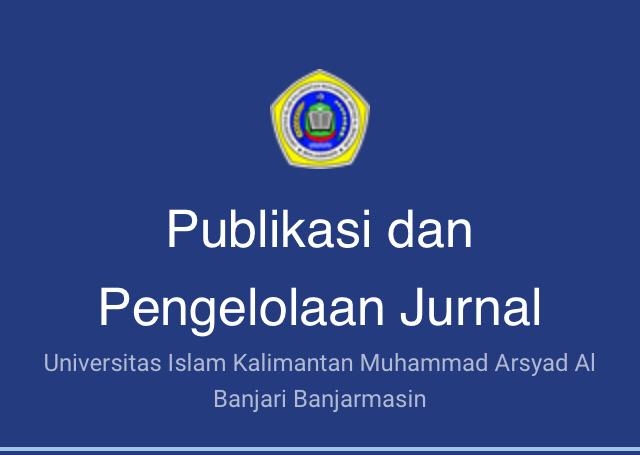Penerapan Technology Acceptance Model Terhadap Perilaku Pengguna Uang Elektronik
(1) UNISKA MAB
(2) UNISKA MAB
(*) Corresponding Author
Sari
The acceptance of new technology generally uses Technology Acceptance Model as an approach model to explain how the users accept new technology. The constructs of the technology acceptance model are perceived ease of use, perceived usefulness, attitude toward using, and actual usage. This research aims to examine whether perceived ease of use and perceived usefulness affect attitude toward using and actual usage of the use of electronic money to obtain empirical evidence on how public acceptance of the use of electronic money, especially among users at private colleges and universities in Banjarmasin. 150 participants participated through questionnaires that were delivered by Google Form. Partial Least Square (PLS) with Smart PLS 3.0 is the tool for analyzing data. The results show that perceived ease of use and perceived usefulness affect attitude toward using and actual usage, and attitude toward using also affects actual usage of the use of electronic money.
Kata Kunci
Teks Lengkap:
PDFReferensi
Chin, W. W. (1998). The Partial Least Squares Approach to Structural Equation Modeling. Modern Methods for Business Research, 295, 336
Davis, F.D. 1989. Perceived Usefulness, Perceived Ease of Use, and User Acceptance of Information Technology”, MIS Quarterly, Vol. 13, No. 5, pp. 319-339.
Davis, F.D. 1993. User Acceptance of Information Technology: System Characteristics, User Perceptions and Behavioural, International Journal Management Machine Studies, Vol. 38, pp. 475-487.
Irawati, Rimawati, & Pramesti, (2019). Penggunaan Metode Technology Acceptance Model (TAM) Dalam Analisis Sistem Informasi Alista: Accounting Information Systems and Information Technology Business Enterprise, Volume 04, Nomor 02 (2019) Hal. 106-120 ISSN: 2252-9853
Kusumadewi, Lubis, Prastiyo, & Tamara, (2021). Technology Acceptance Model in the Use of Online Learning Applications during the Covid-19 Pandemic for Parents of Elementary School Students. Edunesia: Jurnal Ilmiah Pendidikan p-ISSN 2722-5194 Vol 2 No 1 Januari 2021.
Lazrina Md Lazim, et al (2021). Application of Technology Acceptance Model (TAM) towards Online Learning during Covid-19 Pandemic: Accounting Students Perspektive: International Journal of Business, Economics, and Law, Vol. 24, Issue 1 (April) ISSN 2289-1552 2021.
Masrom, M. (2007). Technology Acceptance Model and E-Learning. 12th International Conference on Education, Sultan Hassanal Bolkiah Institute of Education Universiti Brunei Darussalam 21-24 May 2007.
Ozturk, A. B., Bilgihan, A., Nusair, K., & Okumus, F. (2016). What keeps the mobile hotel booking users loyal? Investigating the roles of self-efficacy, compatibility, perceived ease of use, and perceived convenience. International Journal of Information Management. https://doi.org/10.1016/j.ijinfomgt.2016.04.005
Ratnaningrum, (2013). Aplikasi Model TAM Terhadap Pengguna Layanan Internet Banking di Kota Denpasar. Program Magister Program Studi Manajemen Program Pasca Sarjana Universitas Udayana Denpasar – Tesis
Rigopoulos, George, Dimitrios Askounis. (2007). A TAM Framework to Evaluate User’s Perception toward Online Electronic Payments. Journal of Internet Banking and Commerce, December, Vol. 12, No. 3, pp. 1-5.
Sani, A., Wibawa, A. P., & dkk. (2020). The Effect of Student Behaviour on the Use of Campus Journal By Adapting The TAM. Jurnal Ilmu Pengetahuan Dan Teknologi Komputer Vol. 6. No. 2 February 2020. DOI: 10.33480/Jitk.v6i2.1969.
Sayekti, F., & Putarta, P. (2016). Penerapan Technology Acceptance Model (TAM) Dalam Pengujian Model Penerimaan Sistem Informasi Keuangan Daerah. Jurnal Manajemen Teori Dan Terapan Tahun 9. No. 3, Desember 2016.
Sulastini, & Warmika, (2018). Aplikasi TAM, Persepsi Risiko, dan Kepercayaan dalam Menjelaskan Niat Menggunakan Internet Banking. Fakultas Ekonomi Dan Bisnis Universitas Udayana (Unud), Bali, Indonesia.
Sumerta, I. K., Widyagoca, G. W. P. A., Adiandari, A. M., & Herlambang, P. G. D. (2019). Analysis of Technology Acceptance Model (TAM) to Use E-Money in Bali Province. International Journal of Advanced Trends in Computer Science and Engineering, Vol 8(No.15).
Tasmil, & Herman. (2015). Fisherman Acceptance of GPS Technology Based on Technology Acceptance Model. Jurnal Pekommas, Vol. 18 No. 3, Desember 2015: 161 - 170.
Wang B. & Ha-Brookshire J.E. (2019). Perceived Cost of New Technology Adoption: Scale Development in the Context of Chinese Textile and Apparel Firm Managers. International Textile and Apparel Association Annual Conference Proceedings.
Widjana, Mahardika Aditya, dan Basuki Rachmat. 2011. Factor Determining Acceptance Level of Internet Banking Implementation. Journal of Economics, Business, and Accountancy Ventura. Vol. 14 No. 2. pp. 161-174.
Wu, Jun. (2013). The Adoption of Internet Banking in a Developing Economy. Journal of Economics and Behavioural Studies. Vol. 5, No. 8, pp. 496- 504.
DOI: http://dx.doi.org/10.31602/al-kalam.v10i1.9019
Refbacks
- Saat ini tidak ada refbacks.

Al Kalam : Jurnal Komunikasi, Bisnis, dan Manajemen by https://ojs.uniska-bjm.ac.id/index.php/alkalam/index adalah ciptaan disebarluaskan di bawah Lisensi Creative Commons Atribusi-BerbagiSerupa 4.0 Internasional.









